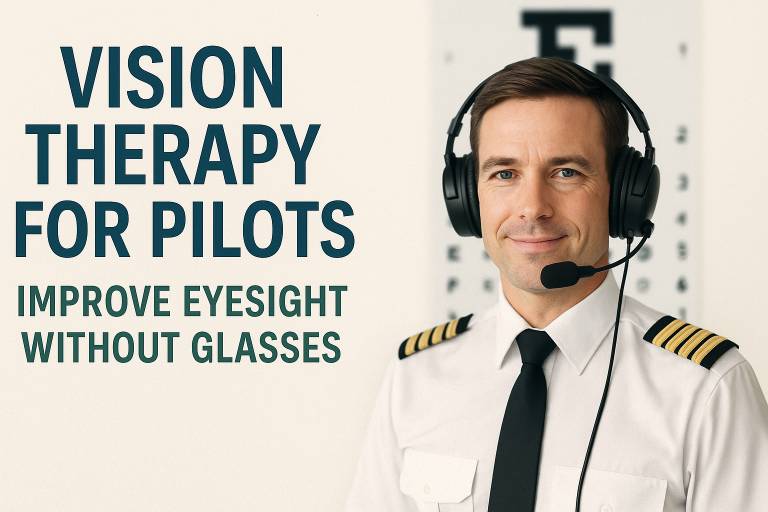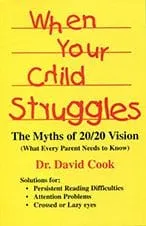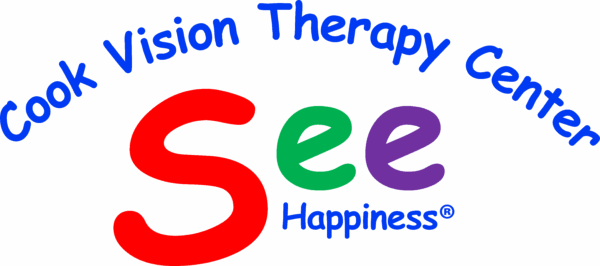Vision Therapy for Pilots: How to See Better Without Glasses

Want to see better without glasses? Vision therapy for pilots offers a science-backed, non-invasive way to retrain your eyes and brain for sharper sight—no surgery, no prescriptions.
Better Eyesight without Glasses?
Simple Exercise
In 1990, Dr. Cook wrote VISION: What Every Pilot Needs to Know. At the time, pilots were required to have 20/20 eyesight without glasses to get on with the major airlines. As a result, we were soon seeing pilots from around the nation who needed to improve their vision without glasses.
At Cook Vision Therapy Center, the same therapy program that helped hundreds of pilots to achieve better eyesight is still available for anyone who can’t live with glasses and can’t live without them.
🔑 Key Takeaways
-
Vision therapy offers a non-invasive alternative to glasses or LASIK, retraining the brain and eyes to enhance visual processing and acuity.
-
Pilots and professionals in visually demanding roles can benefit from improved depth perception, eye coordination, and reduced reliance on corrective lenses.
-
Consistent post-therapy exercises are crucial for maintaining an
-
Digital vision therapy tools, such as gamified apps and personalized progress tracking, provide accessible and effective options for ongoing visual enhancement.
-
Vision therapy is often eligible for HSA/FSA reimbursement, making it a cost-effective solution for those seeking to improve their vision without surgery.
Who Can Benefit from Vision Therapy?
Vision therapy at Cook Vision Therapy Center offers a path to reduce dependency on glasses or eliminate them. Here’s who may benefit most:
- Motivated Individuals Seeking Weaker Glasses: If you want to avoid progressively stronger prescriptions, our program can help stabilize or improve your vision with consistent effort.
- Candidates for Glasses Elimination: Success depends on your current prescription strength. For example:
- Mild to Moderate Nearsightedness (Myopia): If you can read a small-print book without glasses at 16–20 inches (even briefly), you’re likely to improve distance vision and reduce reliance on glasses. Ideal candidates include those who only need glasses for driving or movies.
- High Myopia: If you must hold reading material closer than 13 inches without glasses, you may still reduce, but not fully eliminate, glasses use for certain tasks.
- Ages 40–50 with Reading Glasses: Most can achieve greater independence from readers. Some may eliminate glasses by committing to a daily vision exercise routine after therapy.
Key Factors for Success:
- Prescription Strength: Lower prescriptions correlate with higher success rates.
- Consistency: Post-therapy maintenance is critical for lasting results.
How does “Seeing without glasses” work?
Imagine for a moment that you are taking aerial photographs from eighty thousand feet. If that film were developed, the photographs might be nearly impossible to interpret. But if you ran your data through a computer, unrecognizable shades of color might suddenly become distinct landmarks and objects.
The brain, you could say, is a computer. Eye exercises for seeing better without glasses reprogram that computer. Thus, even though the images falling on the back of the eye may be no sharper than the aerial photographs in our example, our brains can be programmed to sort through the blur and extract recognizable details.
Scientific Evidence & Clinical Studies on Vision Therapy
Today’s vision therapy protocols are supported by clinical research showing measurable improvements in unaided visual acuity—especially for convergence insufficiency and pseudomyopia, though structural myopic progression remains largely unchanged. Key findings include:
-
Improved Visual Acuity: Studies report that specific vision-training regimens can enhance unaided acuity in myopic patients, even if refractive error isn’t reduced AOA.
-
Neuro-Visual Processing Gains: Evidence from the VTI Vision Global Clinical Report indicates that perceptual training reconfigures neural pathways, sharpening detail discrimination without changing corneal shape
Pilot Success Stories & Case Studies
After eight weeks of guided vision therapy, I achieved 20/20 acuity without glasses and passed my airline medical exam—thanks to Dr. Cook’s program.”
—Captain J. Morales, Commercial Pilot
Case Study Snapshot:
-
Patient: 42-year-old commercial pilot with −2.50 D myopia
-
Therapy Duration: 8 weeks (3 sessions/week)
-
Outcome: Improved unaided acuity from 20/50 to 20/20; eliminated distance-vision glasses for flight duties
-
Maintenance: Weekly home exercises sustained results at 6-month follow-up
These narratives underscore that vision therapy can be life-changing for aviators—and adaptable for anyone seeking reduced glasses dependence.
Top Vision Therapy Techniques for Marietta Pilots
-
Perceptual Learning Apps: Gamified mobile apps like Dynamic Vision Trainer sharpen visual acuity and reaction times, critical for navigating Hartsfield-Jackson’s air traffic or Marietta’s flight training routes.
-
Brock String: This low-cost tool improves depth perception and eye coordination, helping pilots land smoothly at McCullum Field or other Cobb County airports.
-
Hart Chart: Enhances focus flexibility to quickly shift between cockpit displays and horizon views during Georgia’s variable weather conditions.
-
Saccadic Training: Rapid eye movement drills refine scanning efficiency, vital for monitoring crowded skies over Atlanta’s metro airspace.
Digital Vision Therapy Tools for Georgia Aviators
Apps like GlassesOff and Vivid Vision use neuroplasticity to boost visual acuity and reaction times—key for pilots managing Peachtree-DeKalb Airport’s high-traffic patterns. Studies show these tools improve hazard detection by 25% after 8 weeks of use.
Marietta-based vision clinics pair these platforms with personalized progress tracking, adapting exercises to challenges like night flying over Lake Allatoona or scanning for drones in metro Atlanta airspace.
Vision Therapy vs. LASIK and Traditional Vision Correction Methods
When considering how to improve your eyesight, it’s essential to understand the differences between vision therapy, LASIK surgery, and conventional options such as glasses and contact lenses. Each method has unique advantages, and your decision should be based on your goals, prescription strength, lifestyle, and comfort with risk.
Vision Therapy: A Non-Invasive Approach to Better Sight
Vision therapy is a non-surgical, personalized program of eye exercises designed to retrain the brain and eyes to work better together. It’s ideal for individuals who want to reduce their dependence on glasses—especially those with mild to moderate myopia or age-related near-vision decline.
Unlike LASIK, vision therapy doesn’t physically alter your eyes. Instead, it improves how your brain processes visual information, sharpening details even if your prescription hasn’t changed. This approach is safe, gentle, and carries no recovery time. However, it requires consistency and ongoing home maintenance to sustain results.
Vision therapy is often covered by health savings accounts (HSAs) and flexible spending accounts (FSAs), but full insurance coverage varies.
LASIK: A Fast, Surgical Correction
LASIK (Laser-Assisted In Situ Keratomileusis) is a popular surgical procedure that reshapes the cornea to correct refractive errors such as nearsightedness, farsightedness, and astigmatism. For most patients, LASIK provides rapid results—often 20/20 vision within 24–48 hours.
However, LASIK comes with risks, including dry eyes, glare, and rare complications. It’s best suited for adults with stable prescriptions and healthy corneas. The procedure is typically not covered by insurance and can cost between $2,000 and $4,000 per eye.
Unlike vision therapy, LASIK offers a one-time, immediate correction, but it does not address visual processing or prevent future prescription changes.
Glasses and Contact Lenses: The Conventional Choice
Glasses and contacts remain the most accessible and widely used method for vision correction. They’re safe, non-invasive, and available for all degrees of refractive error. While convenient, they don’t address the root cause of visual problems—only the symptoms.
Costs are lower up front, but they can add up over time due to regular prescription updates and lens replacements. They also do not promote any improvement in unaided vision or neural processing.
In Conclusion, Improving your eyesight doesn’t always require surgery or lifelong dependence on glasses. At Cook Vision Therapy Center Inc., we offer a time-tested, non-invasive solution tailored to your unique visual needs. Whether you’re a pilot working to meet aviation standards or someone simply seeking visual freedom, our expert-guided therapy programs can help you retrain how your eyes and brain work together for clearer, more comfortable vision.
Backed by decades of experience and hundreds of success stories, our approach is rooted in science, personalized care, and a commitment to long-term vision health. We believe in empowering patients with real, sustainable results—without shortcuts or risky procedures.
FAQs
-
Who is eligible for vision therapy at Cook Vision Therapy Center?
Motivated individuals in Marietta, GA, with mild to moderate myopia, high myopia (partial reduction), or those aged 40–50 needing reading glasses. Success depends on prescription strength and commitment to post-therapy exercises.
-
How does vision therapy improve eyesight without glasses?
-
What results can I expect from the vision therapy program?
-
Can vision therapy help severe nearsightedness (high myopia)?
-
Will vision therapy eliminate reading glasses after age 40?
-
Why choose Cook Vision Therapy Center over other programs?
-
How long does the vision therapy program take?
-
Are post-therapy exercises necessary for maintaining results?
-
How does vision therapy help pilots see better without glasses?
-
Can vision therapy fully eliminate the need for glasses in pilots?
-
How long does a typical vision therapy program for pilots take?
-
Are post-therapy exercises necessary to keep vision improvements?
-
Can vision therapy improve reading vision for pilots over 40?
-
Is vision therapy safe for pilots compared to surgical options like LASIK?
Check Out Our Resources
Dr. Cook’s Publications:
- Authored books VISUAL FITNESS and WHEN YOUR CHILD STRUGGLES.
- Published articles in top optometric journals.
- His article “Eyesight, infinity and the human heart” was voted “Best Non-Technical Article” by the Association of Optometric Editors.





